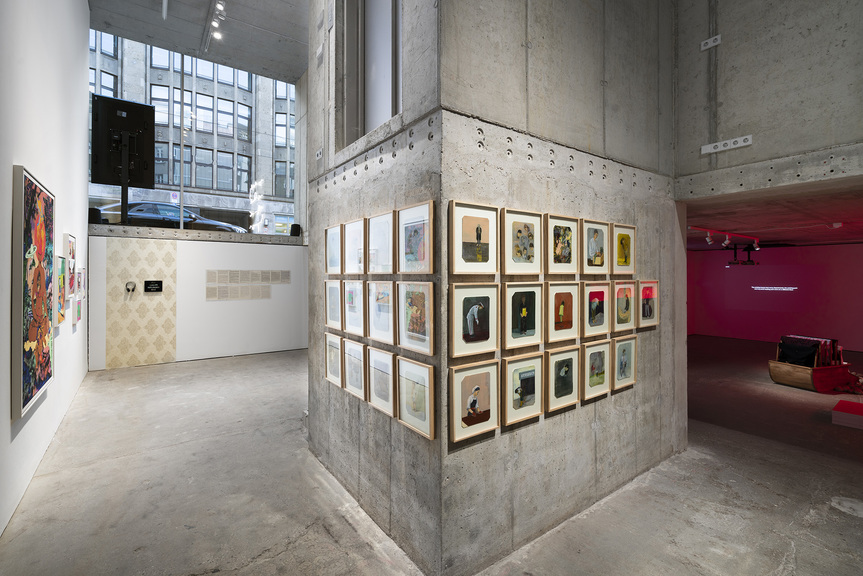-
From Current Issue
-
- Editor’s Letter Fire in the Heart
- Reviews I Gusti Ayu Kadek Murniasih
- Reviews 11th Seoul Mediacity Biennale: “One Escape at a Time”
- Dispatch Networked China
- One on One Monira Al Qadiri on Yukio Mishima
- Essays The rise of independent art spaces in pandemic-era Shanghai
- Features Tuan Andrew Nguyen
- Table of Contents
- Web Exclusives
- Archive
- Subscribe

R
E
V N
E
X
T
Installation view of “Neither Black / Red / Yellow Nor Woman,” at Times Art Center Berlin, 2019. Photo by graysc. Courtesy Times Art Center Berlin.
When art historian Mia Yu started looking into the artist Pan Yuliang (also known as Pan Yulin) in 2017, she asked a simple question: “Who are you?” Yu wasn’t looking for facts—documents on Pan, one of the first women to join Chinese and European artist circles in the 1920s and ’30s, are abundant. Yu was after Pan’s personal view as a diasporic female artist, moving between political systems and art schools in China and France. Yu’s video installation Pan Yuliang: A Journey from Silence (2017), a table inlaid with a screen, displays an overhead shot of the researcher’s hands assembling photographs and archival material while she narrates her discoveries and lingering questions. Her essayistic search was the first in many delightful works on view in the exhibition “Neither Black / Red / Yellow Nor Woman,” at the Times Art Center Berlin.
Curated by Guangdong’s Times Art Museum curator Nikita Yingqian Cai and Xiaoyu Weng of New York’s Solomon R. Guggenheim Museum, the extensive group show of 19 artists departed from an imaginary encounter between three extraordinary Asian women in the arts—Pan Yuliang, novelist and artist Theresa Hak Kyung Cha (1951–82), and artist and researcher Trinh T. Minh-ha. It was a thought experiment aimed at bringing together diasporic positions not in an abstract framework, but through personal (art) histories.
Installation view of CHANG WEN-HSUAN’s ___’s Autobiography, 2016, audio guides, documents, fabrics, counterfeit money, knife, and trolley, dimensions variable, at “Neither Black / Red / Yellow Nor Woman,” Times Art Center Berlin, 2019. Photo by graysc. Courtesy the artist and Times Art Center Berlin.
One floor below the entrance was Cheng Wen-Hsuan’s ___’s Autobiography (2016), an installation of red plinths displaying various personal items, from a suitcase filled with scraps of Communist Party documents to piles of clothes, books, and photographs. A pseudo-autobiographical audio guide in Hokkien walked visitors through these objects with reference to the life stages of the Taiwanese politician Hsieh Hsueh-hung (1901–70), whose notorious identity as both a persecuted and celebrated communist and women’s rights activist has been appropriated by narratives of Taiwanese independence movements and the Chinese government alike.
Next to Cheng’s work was Shen Xin’s sensual video Warm Spell (2018), shown on a large screen. Shot on the touristy Thai island Ko Yao Yai, the work focused on the complexities of climate change and the problematic, overtaking sightseeing culture, paralleled with candid depictions of two female Asian lovers in a hotel.
A poignant but witty critique of predominantly white and male narratives in art history appeared in Evelyn Taocheng Wang’s short video The Interview (2017). The artist explores the storage of Haarlem’s Frans Hals Museum, tracing European painting’s influence on her artistic practice while accompanied by a thong-clad, sculpted white man in the background. Down the stairs was Wang’s Shirt Boat (2017), an elegant floor installation with shirts by the French brand agnès b. hung over low wooden racks and surrounded by small rocks. The lightness of Wang’s own prêt-à-porter wardrobe was combined with the restless sense of departure by boat—a reference to Wang’s home harbor in Rotterdam. The artist’s unassuming monument gestured at struggles of being shaped and weighed down by cultural garments, paired with the anxiety of fitting into social personas.
Cultural and emotional displacement underpinned many other works on this floor. Phan Thao Nguyen’s Looking Down (2013– ) series lined two sides of a concrete column in the space. The myriad small oil-on-X-ray-film paintings of delicate, bent-down figures were inspired by a 20th century photograph of a woman from Japanese-occupied Indochina bowing to soldiers. Phan’s reflections on the submissive posture contrasted with the flashy works by Chitra Ganesh. The artist’s bold, apocalyptic comic strips populated by South Asian deities sitting in jungles next to spacecrafts envisioned mythological encounters driven by feminist, queer, and multiethnic iconographies. Meanwhile, Metropolis (2018), her digital animation of a lightning-throwing cyborg Maitreya Buddha, was displayed in an upstairs window for outside passersby to see.
“Neither Black / Red / Yellow Nor Woman” offered enumerable encounters with female subjectivities. Exiting the gallery, I found my efforts to recollect the abundant artistic agencies assembled in this show mirroring Yu’s vague rummage through Pan’s documents as seen at the start—the stories were impossible to grasp, yet remained deeply tangible.
“Neither Black / Red / Yellow Nor Woman” is on view at the Times Art Center, Berlin, until January 4, 2020.
To read more of ArtAsiaPacific’s articles, visit our Digital Library.


















